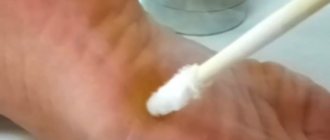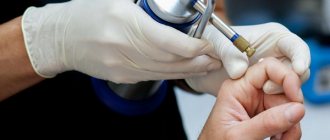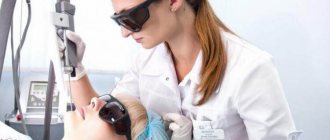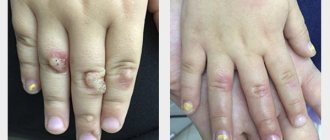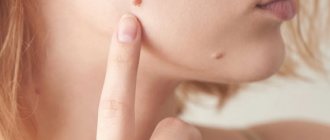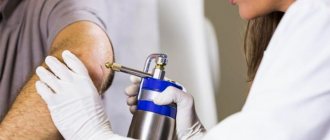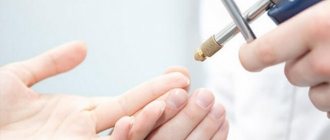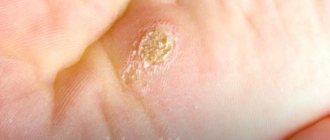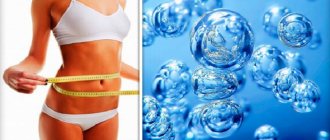From this article you will learn:
- What is cryotherapy
- For what purposes is cryotherapy used in a beauty salon?
- What is the effect of cryotherapy
- What are the indications and contraindications for cryotherapy?
- How to care for your skin after cryotherapy
Beauty is made up of many factors. This includes spiritual purity, graceful body shape, and hair condition. But all this will fade into the background if the face is not beautiful, if pimples, constant oily shine or wrinkles appear on it. Modern women are very lucky, because there are a lot of cosmetic methods that can restore the pristine beauty of the skin in the shortest possible time. One of them is cryotherapy in a beauty salon. What kind of procedure is this? Let's figure it out.
Treatment of alopecia areata with cryotherapy
The content of the article
For focal alopecia, superficial freezing using the deep “Deep steak” method, contact method or spray method is used.
Freezing a swab immersed in liquid nitrogen combined with pressure is done by rolling it over the skin for about 5-7 seconds. Freeze by contact or spray method for 5-10 seconds. once or twice. Cryotherapy is repeated 1-2 times a week in 4-8 week cycles or every other day 15 times per cycle.
Treatment of alopecia areata with cryotherapy
The cycles should be repeated four times with monthly breaks. The results of cryotherapy for alopecia areata are encouraging. However, the procedures should be carried out very carefully, because even a short-term excessive drop in temperature can damage the hair follicles. So the “Deep steak” method remains the safest. You can also freeze areas of baldness with ethyl chloride 2 times a week (regrowth takes place after about 10-12 freezes).
Cryotherapy for acne vulgaris and rosacea
For acne vulgaris and rosacea, pustular, papular and larger cysts are suitable for cryosurgery. Blackheads cannot be treated with cold.
Best results are achieved using the 2-5 second spray method for small and superficial lesions, up to 5-20 seconds for larger cysts. Shallow lesions and cysts on the skin of the torso and chest respond best to treatment.
Using the Spray Method to Treat Acne Vulgaris and Rosacea
The same thing happens with rosacea. In the case of nodular changes in the nose (rhinophyma), due to their significant blood supply, in order to achieve sufficiently deep necrosis, it is necessary to spray the drug for about 20-40 seconds or repeat the treatment after two months. The mechanism of action of cryotherapy for acne is to cause atrophic changes in the skin appendages.
Expected Result
Cryotherapy has many advantages - it is painless, can rejuvenate the skin, remove blemishes, fight cellulite, and helps lose weight. This occurs due to the activation of internal metabolic processes, and not drugs. Cold treatments are highly effective and show results from the first sessions.
It is important to choose a clinic where competent specialists will help the body, with the help of cold, learn to adapt to unfavorable conditions and stress. Cryotherapy must be done in a course for greater effectiveness.
This is an inexpensive way to maintain health. Cryotherapy is a reliable prevention of many diseases. The price depends on the clinic and city; currently such services are provided not only in Moscow, but also in many large cities of Russia.
Treatment of granuloma annulare with liquid nitrogen
Treatment of granuloma annulare, which consists of freezing with ethyl chloride or snow paste, has been used for a long time. Spraying with liquid nitrogen for 20-30 seconds is less commonly used. Treatment can be repeated after 4 weeks. For lesions with a diameter of more than 3 cm, it is sufficient to freeze only the peripheral part. Rashes in the form of disseminated granuloma annulare cannot be treated with cryosurgery.
Granuloma annulare
For nodular prurigo, cryosurgical treatment results in rapid resolution of the lesions. The best effect is achieved when using applicators with a diameter corresponding to the size of the nodules, with double freezing in 15-45 seconds. However, the results of treatment are not permanent. The itching usually recurs after a few months.
Localized scabies is indicated for treatment by spraying the product repeatedly and freezing the surface without blistering, which results in short-term relief of symptoms and easier lesions.
Cryotherapy for lupus erythematosus
In lupus erythematosus, cryotherapy is particularly useful in treating the discoid form (DLE). The method can be used several times, with an interval of 7-14 days, lasting 2-5 seconds. Freezing is carried out with solidified carbon dioxide in the form of sticks or a mixture with ether or gasoline.
Liquid nitrogen is used less frequently.
Double freezing using the spray or contact method for 15-60 seconds also gives good results. Freezing too shallow promotes relapses. In large lesions with active lesions along the periphery, it is preferable to freeze only the marginal part with a spray.
Cryotherapy for DVE may be an alternative to intralesional corticosteroid injections, reducing itching and leaving flat, discolored scars. In some patients, this may prevent the development of tumors in the lesions.
Other indications for the use of cryotherapy methods in dermatology include: Mibelli porokeratosis, lichen sclerosis and atrophic lichen, cirrhosis of the penis, Passini-Pierini atrophoderma. and etc.
Cryosurgery is also used for the removal of ingrown toenails, tattoo removal, some tropical mycoses, cutaneous leishmaniasis, larva migrans infections, psoriasis, and the treatment of purulent skin conditions such as boils, carpal furuncles, strokes, and abscesses.
Advantages of hardware VKT
Carrying out VCT has undeniable advantages over other methods of cryotherapy:
- Environmental friendliness (ordinary atmospheric air acts as a cooling medium).
- Safety (short-term exposure to cold eliminates the threat of frostbite and complications).
- Versatility (wide range of therapeutic applications: rheumatology, neurology, orthopedics, surgery, dermatology, cosmetology, sports medicine).
- There is no need for preliminary preparation for the procedure and subsequent rehabilitation.
Contraindications to cryotherapy
When qualifying patients for treatment with this method, numerous general and local contraindications should be taken into account.
- The coexistence of pathological formations, the exacerbation of which can be caused by local temperature changes:
- cryoglobulinemia;
- cryofibrinogenemia;
- cold agglutinin disease;
- cold erythema;
- inflammation of the subcutaneous tissue from cold;
- Raynaud's disease.
Cold erythema
2. Diseases and treatment procedures that prevent proper healing after freezing:
- connective tissue diseases and autoimmune diseases,
- multiple myeloma,
- thrombocytopenia,
- agammaglobulinemia,
- pyoderma gangrenosum,
- immunosuppressive treatment,
- dialysis therapy.
Taking into account the localization, it is not recommended to perform cryosurgery for changes:
- on the lower leg - due to prolonged healing,
- on the free edge of the wings of the nose and at the border of the labial red (especially the upper lip) - due to the risk of unsightly scars (this mainly applies to cases requiring deep freezing),
- into the ear canal - due to the risk of facial paralysis.
Indications
The influence of low temperatures stimulates the functioning of the circulatory system, which heals and rejuvenates the entire body. The benefits of the procedures will be felt for a long time. Cryotherapy is aimed at restoring strength and improving well-being.
The indications are:
- cleansing the skin of defects;
- getting rid of acne;
- removal of warts, papillomas;
- general rejuvenation;
- treatment and prevention of baldness;
- rehabilitation after operations and injuries;
- treatment of inflammation of joints and bones;
- removal of edema;
- assistance in the treatment of the reproductive and respiratory systems;
- application in plastic surgery.
Low temperatures help in the fight against excess weight. Diets also work effectively, while the skin remains tightened and smooth.
Side effects and complications after cryotherapy
Their occurrence and severity depend on the depth of freezing, the location and size of the treated lesion.
Complications after cryotherapy are divided into:
- immediate;
- early;
- late;
- permanent.
Most direct reactions are always occurring phenomena. Their unexpected intensity should be cause for concern.
Immediate complications:
- Pain (17.8%) - can occur with any treatment, even when using the stick method. Re-freezing usually causes less discomfort. The pain intensifies during defrosting and can last up to several hours. It's like an aching ripple. Particularly sensitive areas are: fingertips, nail shafts, soles, ears, helix of the ear, lips and mucous membranes, temporal and frontal areas (due to the ease of irritation of the periosteum);
- Edema (7.9%) is considered a side effect if it affects the tissue surrounding the treated lesion and is negatively assessed by the patient. The area around the eyelids is most susceptible; After treatment of lesions in this area, swelling may appear in the upper cheeks, nose, forehead and front of the scalp. Other vulnerable areas: lips, foreskin, labia, especially small ones. Swelling after cryotherapy procedures is more common in children;
- Bleeding - may occur after cryotherapy with applicators covered by highly perfused vascular or cancerous granuloma nodes. There is also a risk of bleeding when treating lesions that have previously been biopsied or if part of the tumor has been cut before surgery;
- Excessive reaction in the form of blisters - especially painful when the soles are affected;
- Gas penetration into the subcutaneous tissue occurs in exceptional cases when ulcerative tumor foci are frozen by spraying or with a fresh biopsy defect, especially in the lower eyelids. It occurs with a characteristic “crackling” of exfoliating tissues;
- Fainting - most often occurs in young people as a neurovegetative reaction with a drop in blood pressure and increased sweating (especially if the procedure was performed with the patient in a supine or supine position);
- Infection after surgery - the greatest risk of secondary infection occurs in the case of difficult-to-heal ulcers after treatment of lesions located on the lower legs. Prevention of this type of complication involves irrigating the lesions with hydrogen peroxide, applying topical antibiotic dressings, or using antibiotics in general (especially after treating multiple lesions, such as actinic keratoses);
- Feverish reaction.
Feverish reaction
Other rare complications: cardiac arrest, formation of vascular granuloma at the site of freezing, etc.
Early complications:
- Post-inflammatory color changes (0.5%) - appear mainly in people with dark complexions. They may cover the entire freeze field equally or appear as a discolored field border. They are an epidermal symptom - a decrease in the number of melanocytes after cryotherapy is accompanied by their functional hyperactivity. The discoloration disappears after a few months;
- Milia (12%) - some patients have many of them around the perimeter of the freezing field.
Late complications:
- Nerve Damage—Cryosurgical procedures cause reversible impairments of pain, touch, and cold sensation that may persist for several months depending on the location of the affected area. These disorders last the longest and are most pronounced in scars on the trunk and limbs. Motor fibers may also be damaged after treatment at the superficial nerve site. Particular care is required when treating lesions located on the lateral surfaces of the fingers, in the area of the angle of the jaw, in the jaw area, on the lateral parts of the tongue, in the fossa, on the back of the foot. The risk of nerve damage is reduced by using an anesthetic and folding the skin during freezing;
- Vascular granuloma;
- Pseudomalignant scar hyperplasia (1.3%) is a rare phenomenon that usually occurs after treatment of cancerous tumors or ulcers complicated by secondary bacterial infection. At the base of the atrophic scar, a dark red, linear, cohesive, raised body gradually grows, which may resemble a relapse. Places prone to this type of complications are: wings of the nose, upper lip (risk of disfigurement, tightening scar, especially after deep freezing), forehead, bridge of the nose, skin of the sternum, lower eyelid (risk of partial eversion of the eyelid). In exceptional cases, a keloid may form in the scar.
Permanent complications:
- Atrophic scar (2.7%);
- Eversion of the eyelids;
- Alopecia - deeper freezing of changes on the scalp causes persistent alopecia due to the high sensitivity of the hair follicles to low temperatures. Therefore, for cryosurgery it is necessary to carefully select lesions located along the edges of the hair on the forehead and temples, in the eyebrow area and on the skin of the chin in men;
- Color changes (6.9%) - their intensity depends on the duration of freezing. After approximately 6 months, re-pigmentation depends on the migration of melanocytes from the periphery. At this time, it is necessary to apply UV protection measures.
Despite the possible occurrence of the complications described above, cryosurgery still remains the method of choice for the treatment of many diseases in dermatology. Its undoubted advantages:
- relatively low cost of treatment;
- a small percentage of side effects;
- usually does not require anesthesia;
- fast healing;
- very good cosmetic effects;
- the possibility of use in areas that are less accessible to other treatment methods or that are a contraindication to their use;
- the possibility of re-treatment and use in case of ineffectiveness of other treatment methods.
Cryotherapy should be considered as a safe, effective, technically fast and simple method of treatment, allowing the treatment of many dermatoses and a large number of patients in an outpatient setting.
Peculiarities:
The “Cryoflow 1000 IR” device is the only device of its class equipped with a biofeedback system (BFB) with remote temperature control on the skin surface, which completely eliminates the possibility of cold overdose and damage to the patient’s tissues.
Cooled air is supplied to the patient through a hose through nozzles of different diameters that regulate the thickness of the air stream.
Monitoring the temperature on the surface of the skin allows you to objectively assess the temperature at the site of exposure. The required temperature is set on the device; a special remote temperature sensor, combined with an air nozzle holder, measures the temperature and commands the device to increase or decrease the air flow in order to maintain the required therapeutic skin temperature. Cryotherapy with hardware control of the temperature of cooled tissues (CTC) eliminates the possibility of their damage, since it will not allow the tissue to be supercooled below the threshold temperature.
Sources
- Markevich T.: Indications for the use of cryotherapy, 1994;
- Kanmerovsky M.: Cryosurgery for skin diseases, 1997.
- Bembenek M., Zhaka M.: Cryosurgery in the palliative treatment of malignant melanoma, 1997;
- Broniarczyk-Dila G., Janowski P.: Cryotherapy and its use in skin diseases, 1997;
- Jakubiak A.: Use of cryotherapy in the treatment of certain skin diseases, 1990;
- Kashuba A. et al. Cryotherapy with nitrous oxide in dermatological practice, 1995;
- Lis A. et al.: The influence of cryo-application time using liquid nitrogen on the effectiveness of treatment of basocellular epithelioma, 1997;
- Machonko T et al.: Treatment of alopecia areata with liquid nitrogen, 1981;
- Shmurly V. et al.: Cryosurgery. Methods and Applications, 1989.
ONLINE REGISTRATION at the DIANA clinic
You can sign up by calling the toll-free phone number 8-800-707-15-60 or filling out the contact form. In this case, we will contact you ourselves.

